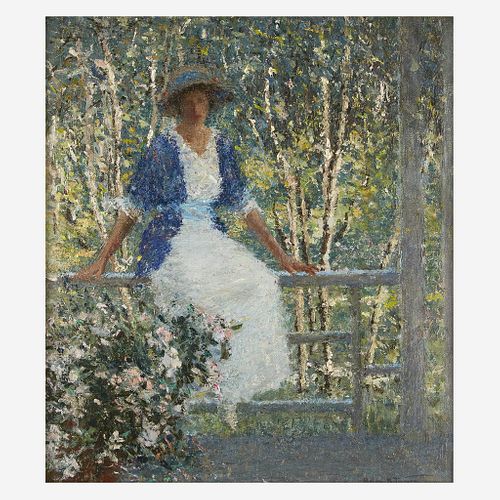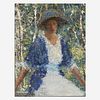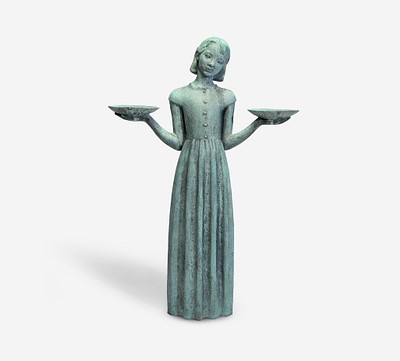Helen Maria Turner (American, 1858–1958) The End of My Porch
About Seller
2400 Market St
Philadelphia, PA 19147
United States
Established in 1805, Freeman’s Auction House holds tradition close, with a progressive mind-set towards marketing and promotion, along with access to a team of top experts in the auction business. And now with offices in New England, the Southeast, and on the West Coast, it has never been easier to ...Read more
Two ways to bid:
- Leave a max absentee bid and the platform will bid on your behalf up to your maximum bid during the live auction.
- Bid live during the auction and your bids will be submitted real-time to the auctioneer.
Bid Increments
| Price | Bid Increment |
|---|---|
| $0 | $25 |
| $500 | $50 |
| $1,000 | $100 |
| $2,000 | $200 |
| $3,000 | $250 |
| $5,000 | $500 |
| $10,000 | $1,000 |
| $20,000 | $2,000 |
| $30,000 | $2,500 |
| $50,000 | $5,000 |
| $100,000 | $10,000 |
About Auction
Jun 6, 2021
Freeman’s is pleased to present Sylvia Shaw Judson’s Bird Girl, the highlight of the June 6 auction. In addition to the sculpture, this auction will also feature several notable works by significant American artists, including Daniel Garber, Norman Rockwell, Edward Redfield, and William Harnett. Freeman's info@freemansauction.com
- Lot Description
Helen Maria Turner (American, 1858–1958) The End of My Porch
Signed and dated 'Helen M. Turner/1914' bottom right, oil on canvas laid down to board
16 x 14 in. (40.6 x 35.6cm)In a period Newcomb-Macklin frame.
Provenance
Private Collection, Virginia.
Footnote:Exhibited
"Fifth Exhibition of Painting by Contemporary American Artists," Corcoran Gallery of Art, Washington D.C., December 15, 1914–January 24, 1915, no. 178.
"One Hundred and Tenth Annual Exhibition," Pennsylvania Academy of the Fine Arts, Philadelphia, Pennsylvania, February 7-March 28, 1915, no. 418.
"Exhibition of Contemporary American Art," Brooklyn Museum of the Arts, Brooklyn, New York, April 5-May 3, 1915.
"Panama-Pacific International Exposition," San Francisco, California, December, 1915.
Literature
W. H de B. Nelson, "Contemporary Exhibitions of Modern Art" in The International Studio, Vol. LIV, no. 216, February 1915, P. CVIII (mentioned, not illustrated).
Maia Jalenak, Helen M. Turner, American Impressionist, Louisiana State University's Master Theses 2216, 2003, pp. 155, 156, 157 (listed, not illustrated).Note
Although she was born in Kentucky in 1858, Helen Maria Turner spent most of her life in the state of Louisiana, and especially in New Orleans, where her family was well-connected. The great-granddaughter of John Pintard, founder of the New York Historical Society and the American Academy of Fine Arts, Turner did not start painting until she was twenty-two. Unlike most of her fellow women artists, she did not seek an education abroad. Instead, she focused on an intense, all-American curriculum, enrolling at Tulane University, the Artist's Association of New Orleans, the Art Students League in New York as well as the Women's Art School in Cooper Union, respectively.
Most of Turner's oeuvre is characterized by her broken, almost pointillist technique and her golden palette, as revealed by the present work, which depicts the young artist herself, sitting nonchalantly upon a porch-rail, and looking directly at the viewer. The work, which earned many celebratory comments when exhibited in 1914-1915, was painted at Cragsmoor, an artist's colony located in the Shawanguck Mountains of upstate New York that Charles C. Curran and his wife, Grace introduced to the artist. In an article entitled "Cragsmoor, an early American art colony," Barbara Buff describes the colony as a haven for artists seeking refuge from industrialization and a return to nature: "Farmers had been clearing the land so that by 1872, there were superb views of surrounding valleys and mountains in every direction. The light and the sky were wonderfully clear and changed often; the air was pure; and breezes blew almost constantly. These were the qualities that attracted artists to Cragsmoor. Throughout its history and even today, the place is also referred to simply as 'The Mountain.'" Turner spent almost all of her summers there from 1906 onwards, and after renting for some time, decided to build her own cottage, which she named Takusan.
At Crasgmoor, while many artists such as Curran, George Inness or William Beard painted open air vistas featuring the nearby forest or meadows, Turner did not venture further than the front of her cottage and rather than depicting the wilderness, she preferred to focus on her flowers and her garden, which the lush, grassy and textured background in the present painting hints at. The artist's front porch at Takusan specifically, was the setting for several of her most acclaimed paintings. Placing an elegant young woman on it, with a garden backdrop in fact became such a winning formula that Turner would go on to repeat in a number of her finest paintings from 1912 to 1923, starting with Summer, Tea Party (Tweed Museum of Art, University of Minnesota), and including Girl with Lantern (Greenville County Museum of Art, Greenville, South Carolina), Morning (Zigler Museum of Art, Jennings, Louisiana), The Flower Girl (The Detroit Institute of Arts, Detroit, Michigan), Lilies, Lanterns and Sunshine (The Chrysler Museum of Art, Norfolk, Virginia), as well as the present work, The End of my Porch.
In the painting, like John Singer Sargent, Curran and Frederick Carl Frieseke before her, Turner immortalizes the poetry of a solitary moment outdoors. She depicted herself in an elegant, light white dress, which perfectly captures the glittering effects of the summer light. The dress is marked by a dashing blue sash at the waist, the only bright color in the composition, which nicely echoes the horizontality of the sitter's hands as well as porch railing, and which subtly contrasts with the verticality of the backdrop, marked by the elegant branches of Turner's birch trees. The result is a perfectly harmonious arrangement of lines, captured in thick brushtrokes, which, when admired from afar, creates an immediate visual sensation of a dazzling summer day from the shade of a well-appreciated porch.
Turner's string of successes with her "woman on a porch" paintings directly led her to being elected a member of the National Academy of Design. Following her success, she shifted her focus to commissioned portrait paintings, and gradually abandoned her favored theme.
Condition report:In overall very good to excellent original condition. With slight ripples in the canvas at upper left and center right (canvas evidently not completely adhered to the board). With some dust along the bottom, right outer edges and at upper right (gray powder dust, not losses). Examination under UV light does not reveal any sign of restoration.
Frame: 28 3/8 x 26 1/2 x 2 in.
- Shipping Info
-
No lot may be removed from Freeman’s premises until the buyer has paid in full the purchase price therefor including Buyer’s Premium or has satisfied such terms that Freeman’s, in its sole discretion, shall require. Subject to the foregoing, all Property shall be paid for and removed by the buyer at his/ her expense within ten (10) days of sale and, if not so removed, may be sold by Freeman’s, or sent by Freeman’s to a third-party storage facility, at the sole risk and charge of the buyer(s), and Freeman’s may prohibit the buyer from participating, directly or indirectly, as a bidder or buyer in any future sale or sales. In addition to other remedies available to Freeman’s by law, Freeman’s reserves the right to impose a late charge of 1.5% per month of the total purchase price on any balance remaining ten (10) days after the day of sale. If Property is not removed by the buyer within ten (10) days, a handling charge of 2% of the total purchase price per month from the tenth day after the sale until removal by the buyer shall be payable to Freeman’s by the buyer. Freeman’s will not be responsible for any loss, damage, theft, or otherwise responsible for any goods left in Freeman’s possession after ten (10) days. If the foregoing conditions or any applicable provisions of law are not complied with, in addition to other remedies available to Freeman’s and the Consignor (including without limitation the right to hold the buyer(s) liable for the bid price) Freeman’s, at its option, may either cancel the sale, retaining as liquidated damages all payments made by the buyer(s), or resell the property. In such event, the buyer(s) shall remain liable for any deficiency in the original purchase price and will also be responsible for all costs, including warehousing, the expense of the ultimate sale, and Freeman’s commission at its regular rates together with all related and incidental charges, including legal fees. Payment is a precondition to removal. Payment shall be by cash, certified check or similar bank draft, or any other method approved by Freeman’s. Checks will not be deemed to constitute payment until cleared. Any exceptions must be made upon Freeman’s written approval of credit prior to sale. In addition, a defaulting buyer will be deemed to have granted and assigned to Freeman’s, a continuing security interest of first priority in any property or money of, or owing to such buyer in Freeman’ possession, and Freeman’s may retain and apply such property or money as collateral security for the obligations due to Freeman’s. Freeman’s shall have all of the rights accorded a secured party under the Pennsylvania Uniform Commercial Code.
-
- Buyer's Premium



 EUR
EUR CAD
CAD AUD
AUD GBP
GBP MXN
MXN HKD
HKD CNY
CNY MYR
MYR SEK
SEK SGD
SGD CHF
CHF THB
THB














